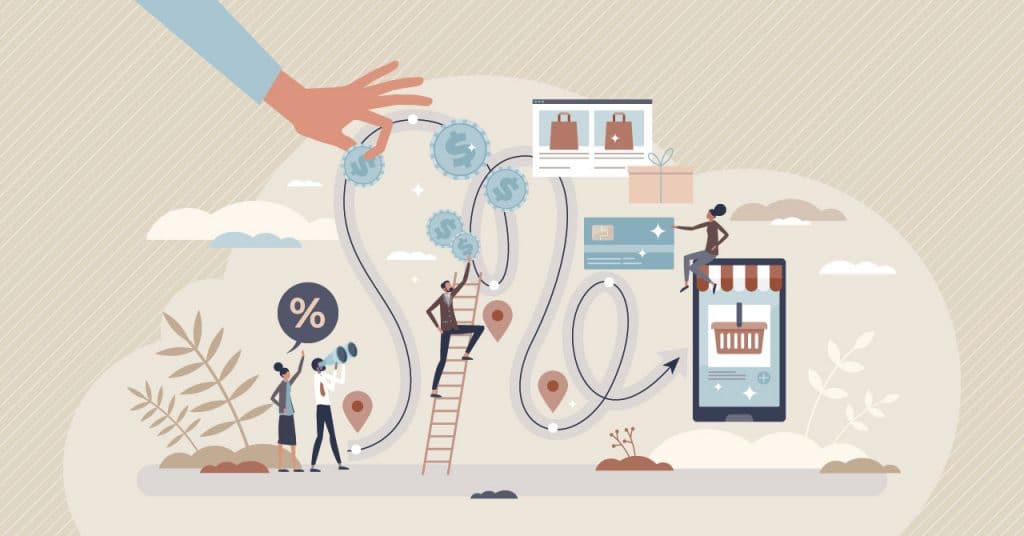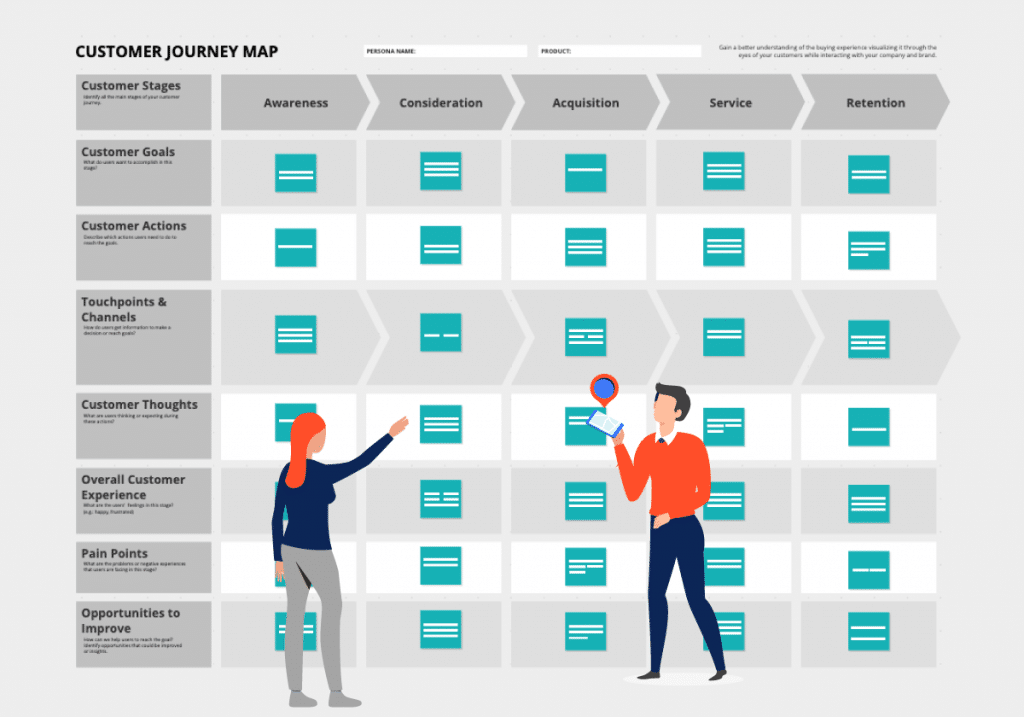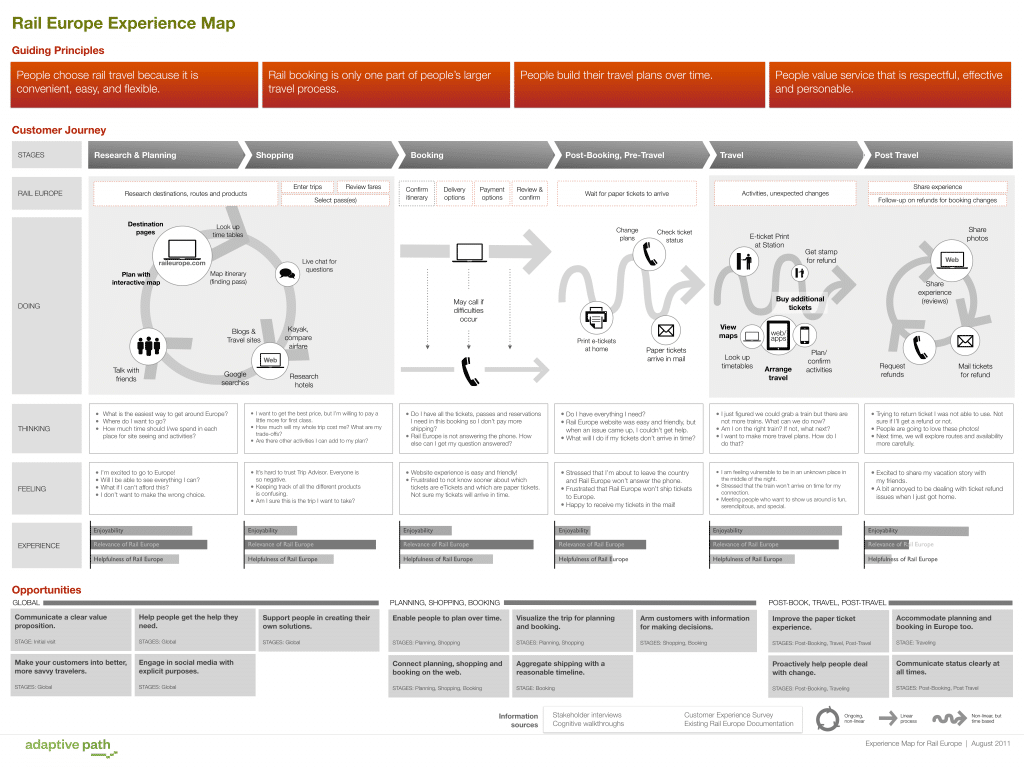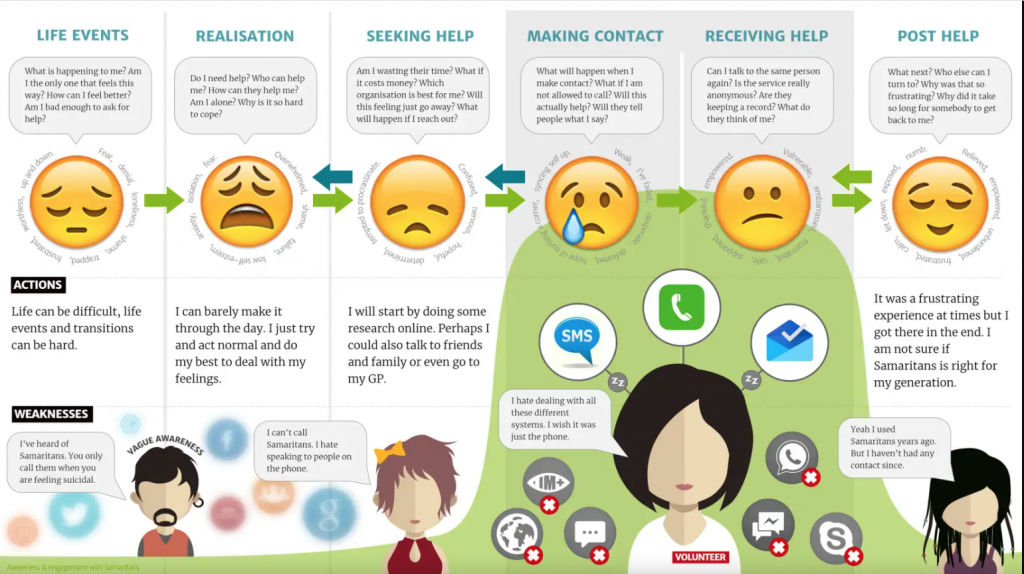What is a Customer Journey Map?
A customer journey map is a visual representation of every direct and indirect interaction the customer has with your company from the first contact to the purchase and after-sales with you, your product or your service.
It involves looking at your company from the customer’s point of view and documenting possible touchpoints, their respective thoughts, feelings as well as their actions at each of these touchpoints with the aim of evaluating them and creating optimizations for the best possible customer experience.
This is intended to turn the initial prospect into a customer and subsequently into a long-term customer.
The process of documentation is also described in technical jargon as customer journey mapping.
In the next chapter, you will learn how customer journey mapping can benefit you and your company.

What are the benefits of customer journey mapping?
If you want to offer an outstanding customer experience from the first contact to the purchase with your company, you need to understand what the customer’s journey looks like and which phases they go through on their journey.
A customer journey map provides the perfect basis for gaining an overview of the current state and, based on this, for initiating and measuring improvements.
Customer journey mapping, the processes during the creation of your map, helps you to show:
- What the entire customer journey looks like from the first touch point to after-sales in your company?
- How the sales process is designed?
- Where problems and discrepancies exist between customer desires and expectations and the actual experience?
- Which interaction points need to be optimized to design a positive customer experience?
- Whether internal conditions need to be adjusted?
So if you too want to create a map for your business, don’t look at the customer journey from your point of view, put yourself in the customer’s shoes and look at and evaluate each interaction point from their point of view.
What are possible phases of a customer journey?
Basically, the customer journey can be divided into several phases. Since there is no uniform classification of the phases, there can be different numbers of phases.
Above all, this always depends on the industry in which you are operating and what your own business model is.
In addition, a purchase is not always made immediately after the first point of contact. This is particularly the case with higher-priced products and services.
The customer first gathers information and usually comes into contact with the brand and the product several times before a purchase decision is made.
But basically, there is always a pre-purchase phase, where the prospect has a need, a problem or a desire to buy, which is triggered by an impulse, an event or another action.
In the pre-purchase phase, research for information as well as potential solutions is a central component.
The pre-purchase phase is followed by the transaction – or purchase phase – in which the initial prospect decides on a vendor or product and completes the purchase.

After the purchase has been made, the post-purchase phase begins, during which the customer has his or her own experience with the purchased product or service and evaluates it.
This factual and emotional evaluation can lead to a long-term commitment or to a termination of the relationship/use of the product.
As mentioned at the beginning, there are no precise ways of dividing the phases. Depending on the industry and business model, there may be other phases in the customer journey.
So think about what the phases might look like at your company before you develop a customer journey map.
What are the possible touchpoints in the customer journey?
Depending on the company, product or service, there can be different numbers of touchpoints along the customer journey. They can be direct, indirect, digital, or even personal.
According to a study on customer touch point management by Esch/Absatzwirtschaft on the occasion of DMEXCO 2016 , the respondents indicated an average of about 221 contact points that take place between a brand and its customers.
That means there are simply a lot of them. But you can group them.
You can do that with the well-known acronym EPOMS.
EPOMS is made up of the words Earned, Paid, Owned, Managed and Shared and describes where possible touchpoints occur from an entrepreneur’s point of view.
Let’s take a quick look at it.
Earned touchpoints are contact points that arise as a result of a company’s good work, for example in the form of ratings, press reports, recommendations, etc.
Paid touchpoints, on the other hand, are contact points acquired between a company and its customers, for example in the form of search and advertising, banner ads, TV and radio spots, and so on.
Owned Touchpoints are when the contact between the company and the customer occurs through the company’s own website, online store, retail store, etc.
Managed Touchpoints are interactions that happen via external platforms such as social media, via apps in the external app store or via an external call center.
And the Shared Touchpoints are interaction points that are shared with others, for example, testimonials, e-books, press articles, forum posts, etc.
What does a customer journey map look like?
If you want to create a customer journey map for your company, there are many ways to present it in terms of content and visuals. Because there is no one right map.
Why?
Because a customer journey map is geared firstly to the company and the phases through which a customer passes, and secondly to the purpose for which the map is to be created. Because the purpose determines the content and the representation of the journey.
But the most common form is the representation of the customer journey as a matrix.

As you can see in the picture, the phases/steps that the customer goes through along the customer journey are entered horizontally.
In the vertical, on the other hand, you can choose which information you want to enter. They should just correspond to your goal.
For an example:
Your goal is to optimize the channels you offer along the customer journey.
For this, you could research the following information in the vertical and include it in your map:
- What is the name of the channel offered?
- Who is the contact person or responsible for the channel?
- What goal(s) should the channel fulfill for the customer?
- What can the customer do with the channel?
- Are there problems & obstacles to using the channel from the customer’s point of view?
- What emotions & feelings does the customer have when using the channel?
- What is the customer’s experience with the channel?
- …
Are there any examples of a customer journey map?
Previously, we talked about how a customer journey map can usually look.
Now I’ll show you examples of how real companies have visualized the customer journey for themselves.
You’ll see that there are creative approaches to how to visualize the Customer Journey and that there’s not just the matrix form.
So let’s start with the first example:
1. Rail Europe Experience Map
As a first example, let’s look at the Customer Journey Map of Rail Europe Inc. The company is a North American distributor of European rail products, of point-to-point tickets and of rail passes for European rail travel.
To optimize the customer experience of rail travelers, they have presented the Customer Journey as a matrix.
In the horizontal one, we see the individual phases that the rail traveler goes through, and in the vertical one, we see what actions the customer takes in each phase, what they think and feel, and what experiences they have in each phase.
In addition, as a result of visualizing the customer journey, they list possible opportunities to optimize the customer experience in each phase.

2. Smithsonian Institute
Our second example is the Customer Journey Map of the Smithsonian Institute, a major U.S. research and educational institution that operates numerous museums.
To optimize their customer experience, they created a map that shows which channels and touchpoints visitors use to engage with the museum at each stage of the customer journey.

3. The Samaritans
Our third example is from the charity organization The Samaritans.
They help people who are struggling financially to meet their living costs.
With their Customer Journey, they describe the problem of each stage of people and how the charity can help them.
The goal is to get people’s attention to help the people and the charity with a donation.

4. Digital experiences
In this and last example, the Customer Journey Map was presented very creatively, not as a matrix, but as a path of a journey.
It is like a kind of story that tells the needs of the customer along his way.
A very nice example that shows that the Customer Journey Map can be presented in different ways, both visually and in terms of content, and that there is no one Customer Journey Map.

How can I create a customer journey map myself?
In order for you to be able to visualize a customer journey for yourself and your company using a map, you need a total of 6 steps.
Please keep in mind that the steps presented here are an orientation for your project.
Depending on what business model you have, what industry you’re in, or what type of company you are, the steps to create your customer journey map may vary.
So let’s start with step 1:
1. Define the goals of the customer journey map
Before you start sketching, you should first consider what goal(s) you are pursuing with the creation of your map.
Because customer journey mapping, as you’ve already learned, can be done for a variety of purposes.
And the goal ultimately determines how the map presents itself visually and what content it needs.
For example, is the goal to visually represent the current customer journey and all direct and indirect touchpoints included, or do you want to visualize a map based on the customer’s behavior, thoughts and feelings along the customer journey.
It would also be possible to visualize in terms of existing or future technologies, methods and processes.
Also, think about who you are creating the map for and why. Should the map be created exclusively for marketing or is service and support also involved. Does the IT department also need to be involved in terms of technologies used.
Depending on which departments and people are also considered for the customer journey map, your goals will look different accordingly.
2. Researching information and collecting data
The better you know your customers and the phases in which they move along the customer journey, the more targeted you can build your customer journey map.
But to do that, you need information.
One source of information about customers in each stage of the customer journey is to ask people in marketing, sales, and customer service and support.
They deal with customers directly or indirectly on a daily basis and can best tell you what stages customers are in at each stage and what touchpoints they use to come into contact with your company.
Another source of information for the customer journey map is to conduct a target group/customer analysis.
With the help of this analysis, you can find out socio-demographic data, their buying and consumption behavior as well as their wishes, expectations and needs.
This information will help you immensely, as you can align your customer journey map more specifically to the target group and customers.
The best way to implement the target group/customer analysis is with an online questionnaire, as you can obtain a lot of valuable information easily and inexpensively. This also helps you to create a buyer persona in the next step.

3. Create a buyer persona
After we have researched and collected all the necessary data and information, this step is about representing the target group using a fictitious customer who represents a real person in terms of demographics, needs, expectations and behaviors.
Buyer personas ultimately reflect a fictitious ideal customer from the target group.
This ideal customer helps us to develop a deeper understanding of the customer for the creation of a customer journey map and to determine for whom we want to optimize the customer experience.
4. Define individual steps and points of interaction
In the 4th step, we now need to consider and describe which steps/phases the customer goes through along their journey and which touchpoints they come into contact with.
Also, describe possible actions and experiences that the customer makes within the phases and what feelings and emotions they experience.
All this information helps us visualize the customer journey in step 5.
5. Visualize the customer journey
Now that you have defined in step 4 which phases of the customer journey your customer goes through and with which contact points he comes into contact with your company, you can visually represent the customer journey in the next step.
Remember, there is no one map.
As I explained to you earlier, the map can look different. Ultimately, it has to match your objective and help you optimize the customer journey.
6. Analyze the customer journey
Once you have created your customer journey map, the next step is to analyze it.
The best way to do this is to become a customer yourself and take the journey on your own.
This gives you a deep insight into the customer journey of your company and allows you to analyze your previous findings and determine optimizations.
You may also find contact points or other things that you hadn’t thought of, so that you can adjust your customer journey map and close any gaps that still exist.
Conclusion: Better understanding of the customer journey with a customer journey map
Okay. We’ve reached the end of my yet very long post about customer journey mapping :).
Let me just say a few words to you in conclusion.
In this post you now got a lot of basic knowledge about Customer Journey Mapping and how you can create your own map for your business.
The goal here is to get an overview and a better understanding of the customer journey your business currently offers.
This will help you optimize the customer experience from the first touchpoint to after-sales in terms of potential needs, expectations, and pain points for the business success of your company.
Remember, a customer journey map doesn’t have a fixed visual representation. It can be visually represented however you want it to be. However, it should fit the purpose for which you are creating the map.
I hope you enjoyed the post and it gives you enough inspiration to think about creating a Customer Journey Map for your business yourself.
If so, good luck with it.
More about Customer Journey
- 8 methods for analyzing the customer journey
- Customer journey management: What it is and why you need it
- The 5 phases of a Customer Journey
- Customer Journey: A central component of the customer experience
- 7 steps to a B2B customer journey strategy
- 5 steps to building an effective customer journey funnel





